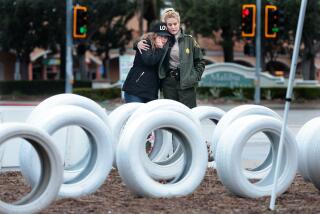Horcher Seeks to Straighten Out Rubbernecks With Legislation
- Share via
Ron Brand got stuck in traffic on the San Gabriel River Freeway--so California may get a law that makes rubbernecking a crime.
Brand was trying to get from Rancho Cucamonga to Long Beach when he came to a dead stop. A truck had jackknifed up ahead, and traffic was backed up for miles.
By the time he got to the accident, the truck was gone. But everybody was slowing down--to look at the tow trucks on the side of the road.
Brand went to his boss, Assemblyman Paul Horcher (I-Diamond Bar), who introduced the Freeway Congestion Relief Act, which would give California Highway Patrol officers the right to ticket motorists who slow down to gawk at an accident.
“What are we going to do, let O.J. out of jail to make room for rubberneckers?” scoffed a Caltrans employee. Actually, the bill calls for a fine, not jail time.
“That’s a great idea, but how are you going to enforce it?” asked Tom Conner, assistant general manager of the Los Angeles Department of Transportation. “There is not much you can do about human nature.”
Human and bovine, apparently. Caltrans spokesman Russ Snyder said traffic experts have found that when something unusual occurs on country roads, “the cows will gather by the fence to see what’s going on.”
But it’s human-spectator slowing that’s a major cause of freeway congestion, say traffic experts who have even studied using inflatable screens to shield accident scenes from freeway looky-loos.
CHP officers have expressed concern that the screens themselves would distract motorists. But James Hanson, the Lawndale inventor of the Traffic Shield, contends that the novelty would wear off and drivers would become accustomed to the 5 1/2-by-16-foot barriers--even if company logos were put on the side as he suggests to cut the cost to taxpayers.
“Essentially, all it is is a fence,” said Hanson, who came up with the idea for the portable barrier after sitting in bumper-to-bumper traffic, then unveiled it at an inventors convention in 1992. “It’s inherently less interesting than the scene of an accident.”
Horcher’s attack on rubbernecking, meanwhile, faces its first legislative hearing in Sacramento today.
“All of us have been frustrated sitting in traffic near the scene of an accident,” said Horcher, best known for his involvement in a different kind of gridlock--the legislative variety--caused when he bolted the Republican Party and provided a key vote to reelect Willie Brown (D-San Francisco) as Assembly Speaker.
Drivers slow down to look at just about any kind of unusual activity on--and off--the freeways (and sometimes linger for the not-so-unusual, such as a motorist changing a tire.) They slow to view smoke in the distance. Or to read banners--such as one installed by Caltrans a few years ago over the Long Beach Freeway that read, ironically, “Keep California Moving.” A few years ago, traffic was backed up on the Santa Ana Freeway by motorists watching a movie being filmed off the freeway.
“If there is a really spectacular crash, sometimes you will get people who will pull over to the side of the road,” CHP Officer Todd Sturges said.
Rubbernecking can reduce freeway capacity 26%, said Alek Jakovljevic, a transportation engineer for the Automobile Club of Southern California.
And it causes fender-benders--or worse. Since accidents are more popular to look at than construction work, Caltrans reports that some of its workers have been injured or killed by curious, careless motorists.
In an effort to save workers’ lives and reduce rubbernecking, Caltrans has installed “gawk screens” atop center dividers during construction work on freeways. But because orange-vested workers themselves can distract motorists, the screens, which require a lot of maintenance, are not standard equipment on freeways.
Caltrans is testing screened-off turnouts on the Santa Monica Freeway where motorists can stop to deal with fender-benders or other problems.
The CHP also tells its officers to turn off their flashing lights after they pull over to the shoulder of the freeway.
Rubbernecking was a reason the freeway service patrol was established in 1991. “The quickest way to eliminate rubbernecking is to eliminate the problem,” said Arthur Anderson, director of the state Office of Traffic Safety. So the patrol has more than 400 tow trucks roaming freeways during rush hour clearing away disabled vehicles, and assisting about 1,000 motorists a day.
The CHP has yet to take a position on Horcher’s bill, but several officers said the vehicle code already says, “No motorist shall slow as to impede traffic.” However, the agency issued only 739 tickets under that section in Los Angeles County last year--far fewer than the number of speeding tickets handed out in one day.
More to Read
Sign up for Essential California
The most important California stories and recommendations in your inbox every morning.
You may occasionally receive promotional content from the Los Angeles Times.











